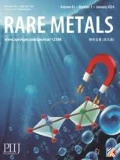Abstract
Polycrystalline Pr2Fe17−x Mn x (x = 0, 1, and 2) alloys were studied by X-ray diffraction (XRD), heat capacity, ac susceptibility, and isothermal magnetization measurements. All the alloys adopt the rhombohedral Th2Zn17-type structure. The Curie temperature increases from 283 K at x = 0 to 294 K at x = 1, and then decreases to 285 K at x = 2. The magnetic phase transition at the Curie temperature is a typical second-order paramagnetic–ferromagnetic transition. For an applied field change from 0 to 5 T, the maximum −ΔS M for Pr2Fe17−x Mn x alloys with x = 0, 1, and 2 are 5.66, 5.07, and 4.31 J·kg−1·K−1, respectively. The refrigerant capacity (RC) values range from 458 to 364 J·kg −1, which is about 70 %–89 % that of Gd. The large, near room temperature ΔS M and RC values, chemical stability, and a high performance-to-cost ratio make Pr2Fe17−x Mn x alloys be selectable materials for room temperature magnetic refrigeration applications.




Similar content being viewed by others
References
Franco V, Blázquez JS, Ingale B, Conde A. The magnetocaloric effect and magnetic refrigeration near room temperature: materials and models. Annu Rev Mater Res. 2012;42(1):305.
Gschneidner KA, Pecharsky VK Jr. Thirty years of near room temperature magnetic cooling: where we are today and future prospects. Int J Refig. 2008;31(6):945.
Oesterreicher H, Parker FT. Magnetic cooling near Curie temperatures above 300 K. J Appl Phys. 1984;55(12):4334.
Wang BZ, Wen M, Cao XM. The research of rare earth magnetic refrigerant materials. Met Funct Mater. 2000;7(4):24.
Mandal K, Yan A, Kerschl P, Handstein A, Gutfleisch O, Müller K-H. The study of magnetocaloric effect in R2Fe17 (R = Y, Pr) alloys. J Phys D. 2004;37(19):2628.
Zhong XC, Zeng DC, Liu ZY, Zhang J. Study on magnetic entropy changes in Ce2Fe16.5Co0.5 alloy. Funct Mater. 2005;36(3):348.
Zhang J, Zeng DC, Zhong XC, Liu ZY, Liao J. Structure and magnetic entropy change of Er2−x Ce x Fe17 compounds. Rare Metal Mat Eng. 2005;34(7):1069.
Zhong XC, Liu ZY, Zeng DC, Zhang J, Wei XZ. Magnetic entropy changes of Er2−x Pr x Fe17 magnetic refrigeration alloys at room temperature range. Mater Eng. 2005;34(7):1065.
Zhong XC, Liu ZY, Zeng DC, Wei XZ. Structure, magnetic properties and magnetic entropy changes of room temperature magnetic refrigeration alloys Pr2Fe17−x CO x rare metal. Mater Eng. 2005;34(10):1537.
Zhou XZ, Jiang WJ, Kunkel H, Williams G. Entropy changes accompanying the magnetic phase transitions in low Si-doped Ce2Fe17−x Si x alloy. J Magn Magn Mater. 2008;320:930.
Tishin AM. Magnetic refrigeration in the low-temperature range. J Appl Phys. 1990;68(12):6480.
Sun ZG, Zhang HW, Wang JY, Shen BG. Structure and magnetic properties of Pr2Fe17−x Mn x (x = 0–9) compounds. J Appl Phys. 1999;86(9):5152.
Pecharsky VK, Moorman JO, Gschneidner KA Jr. A 3-350 K small sample calorimeter. Rev Sci Instrum. 1997;68(11):4196.
Buschow KHJ. Intermetallic compounds of rare-earth and 3d transition metals. Rep Prog Phys. 1977;40(10):1179.
Hong NM, Thuy NP, Franse JJM. Magnetic and anistropy properties of Y2Fe17−xMnx and Er2Fe17−x Mn x compounds. Physica B. 1988;153(1–3):53.
Yelon WB, Hu Z, Chen M, Luo H, Ezekwenna PC, Marasinghe GK, James WJ, Buschow KHJ, Middleton DP, Pourarian F. Neutron diffraction and magnetic studies of Nd2Fe17−x T x (T = Si, Mn) alloys. IEEE Trans Magn. 1996;32(5):4431.
Pecharsky VK, Gschneidner KA Jr. Magnetocaloric effect from indirect measurements: magnetization and heat capacity. J Appl Phys. 1999;86(1):565.
Yamada H. Metamagnetic transition and susceptibility maximum in an itinerant-electron system. Phys Rev B. 1993;47(17):11211.
Gschneidner KA, Jr., Pecharsky VK, Pecharsky AO, Zimm CB. Recent developments in magnetic refrigeration. Mater Sci Forum. 1999;69:315.
Gschneidner KA, Pecharsky VK Jr. Magnetocaloric materials. Annu Rev Mater Sci. 2000;301:387.
Acknowledgments
This work was financially supported by the U.S. Department of Energy by Iowa State University (No. DE-AC02-07CH11358), the Guangdong Provincial Science & Technology Program (No. 2010B050300008), the Scientific Research Foundation for the Returned Overseas Chinese Scholars, State Education Ministry (No. x2clB7120290), the Guangzhou Municipal Science and Technology Program (No. 12F582080022), and the Fundamental Research Funds for the Central Universities (Nos. 2012ZZ0013 and 2011ZM0014).
Author information
Authors and Affiliations
Corresponding author
Rights and permissions
About this article
Cite this article
Zhong, XC., Liu, ZW., Zeng, DC. et al. Magnetocaloric effect of Pr2Fe17−x Mn x alloys. Rare Met. 33, 552–555 (2014). https://doi.org/10.1007/s12598-013-0134-x
Received:
Revised:
Accepted:
Published:
Issue Date:
DOI: https://doi.org/10.1007/s12598-013-0134-x




